Response of a Coral Reef Sand Foundation Densified through the Dynamic Compaction Method
Abstract
:1. Introduction
2. On-Site Test Position and Test Procedures
2.1. Field Zones’ Description and Subsoil Condition
2.2. DC Process on Coral Reef Sand
3. Field Test Results
3.1. Ground Deformation
3.2. Shallow Plate-Load Test and Foundation Bearing Capacity
3.3. Standard Penetration Test (SPT) and Reinforcement Depth
4. Numerical Study of DC Mechanism
4.1. Numerical Algorithm and Validation
4.2. Numerical Analysis of Crater Settlement
4.3. Numerical Analysis of Particle Breakage
5. Conclusions
- (1)
- In both reinforced regions (A1 and A2), the first drop in impact during the three passes (first two tamping points and last full tamping) produced the largest crater settlement, and the crater settlement gradually increased. Full tamping was necessary for the final tamping; the coral sand was well strengthened, and the average total settlements for A1 and A2 were 0.379 and 0.419 m, respectively.
- (2)
- After ground treatment by DC, the allowable ground bearing capacity in both reinforced regions was at least 360 kPa, satisfying the design requirements. The DC method proved to be valid for dealing with reclaimed coral sand.
- (3)
- The SPT field data indicated that the DC reinforcement depths at A1 and A2 were 3.5 and 3.2 m, respectively. The improvement at the impact points was commonly superior to that in the regions between the impact points in the two testing regions. Appropriate spacing of the impact points was necessary to guarantee a uniform strengthening effect in the construction areas.
- (4)
- The DC process for coral sand grounds was reproduced using the particle flow discrete element method. The reinforcement effect and effective reinforced depth were numerically analyzed. The numerical results were consistent with the field investigation data. The fragmentation zone of coral sand caused by DC was primarily distributed immediately below the crater and gradually developed on both sides of the crater with increasing compaction time. The particle force chains after tamping were strong chains in the vertical direction of the crater and weak chains on both sides. This indicates that the particles directly below the ramming point were broken more thoroughly, and the contact between the particles was closer. The dynamic stress wave from the DC energy propagated primarily in the vertical direction.
Author Contributions
Funding
Institutional Review Board Statement
Informed Consent Statement
Data Availability Statement
Acknowledgments
Conflicts of Interest
References
- Zhao, H.T. Researched of coral reef in modern China. World SCI-Tech R&D 1998, 4, 98–105. (In Chinese) [Google Scholar]
- Mejia, L.; Yeung, R. Liquefaction of coralline soils during the 1993 Guam earthquake. Session on Seismically-Induced Movements of Foundations and Abutments. In Proceedings of the 1995 ASCE National Convention, San Diego, CA, USA, 22–26 October 1995; pp. 33–48. [Google Scholar]
- Qiu, W.J.; Yang, H.P.; He, Y.X.; Yu, D.H. Experimental study on coral reef sand as foundation filling material and vibroflotation reinforcement. J. Geotech. Eng. 2017, 39, 1517–1523. (In Chinese) [Google Scholar]
- Ohno, S.; Ochiai, H.; Yasufuku, N. Estimation of pile settlement in Calcareous sands. In Engineering for Calcareous Sediments; Al-Shafei, K.A., Ed.; Baklkema: Rotterdam, The Netherlands, 1999; pp. 1–6. [Google Scholar]
- Lee, C.Y.; Poulos, H.G. Tests on model instrumented grouted piles in offshore calcareous soil. J. Geotech. Eng. 1991, 117, 1738–1753. [Google Scholar] [CrossRef]
- Ismail, M.A.; Joer, H.A.; Sim, W.H.; Randolph, M.F. Effect of cement type on shear behavior of cemented calcareous soil. J. Geotech. Geoenviron. Eng. 2002, 128, 520–529. [Google Scholar] [CrossRef]
- Consoli, N.C.; Cruz, R.C.; Floss, M.F.; Festugato, L. Parameters controlling tensile and compressive strength of artificially cemented sand. J. Geotech. Geoenviron. Eng. 2010, 136, 759–763. [Google Scholar] [CrossRef]
- Xiao, Y.; Stuedlein, A.W.; Chen, Q.; Liu, H.L.; Liu, P. Stress-strain strength response and ductility of gravels improved by polyurethane foam adhesive. J. Geotech. Geoenviron. Eng. 2018, 144, 04017108. [Google Scholar] [CrossRef]
- Liu, L.; Liu, H.L.; Stuedlein, A.W.; Evans, T.M.; Xiao, Y. Strength, stiffness, and microstructure characteristics of biocemented calcareous sand. Can. Geotech. J. 2019, 56, 1502–1513. [Google Scholar] [CrossRef]
- DeJong, J.T.; Soga, K.; Kavazanjian, E.; Burns, S.; van Paassen, L.A.; Al Qabany, A.; Aydilek, A.; Bang, S.S.; Burbank, M.; Caslake, L.; et al. Biogeochemical processes and geotechnical applications: Progress, opportunities and challenges. Géotechnique 2013, 63, 287–301. [Google Scholar] [CrossRef]
- Montoya, B.M.; DeJong, J.T.; Boulanger, R.W. Dynamic response of liquefiable sand improved by microbial-induced calcite precipitation. Géotechnique 2013, 63, 302–312. [Google Scholar] [CrossRef]
- Van Paassen, L.A.; Ghose, R.; van der Linden, T.J.M.; van der Star, W.R.L.; van Loosdrecht, M.C.M. Quantifying biomediated ground improvement by ureolysis: Large-scale biogrout experiment. J. Geotech. Geoenviron. Eng. 2010, 136, 1721–1728. [Google Scholar] [CrossRef]
- Feng, S.J.; Du, F.L.; Shi, Z.M.; Shui, W.H.; Tan, K. Field study on the reinforcement of collapsible loess using dynamic compaction. Eng. Geol. 2015, 185, 105–115. [Google Scholar] [CrossRef]
- Zhou, C.; Yang, C.; Qi, H.; Yao, K.; Yao, Z.; Wang, K.; Ji, P.; Li, H. Evaluation on improvement zone of foundation after dynamic compaction. Appl. Sci. 2021, 11, 2156. [Google Scholar] [CrossRef]
- Hu, B.; Wang, R.; Hu, M.J.; Wang, X.Z. Experimental study on dynamic compaction treatment of hydraulic reclamation sand foundation. Rock Soil Mech. 2007, 28, 89–92. (In Chinese) [Google Scholar]
- Zhou, J.; Cui, J.H.; Jia, M.C.; Shi, D.D. Experimental study on soft foundation treatment with hydraulic fill fine sand. Rock Soil Mech. 2008, 04, 859–864. (In Chinese) [Google Scholar]
- Feng, S.J.; Tan, K.; Shui, W.H.; Zhang, Y. Densification of desert sands by high energy dynamic compaction. Eng. Geol. 2013, 157, 48–54. [Google Scholar] [CrossRef]
- Nashed, R.; Thevanayagam, S.; Martin, G.R. Dynamic compaction of saturated sands and silty sands: Results. Ground Improv. 2009, 162, 69–79. [Google Scholar] [CrossRef]
- Cundall, P.A.; Strack, O.D.L. A discrete numerical model for granular assemblies. Géotechnique 1979, 29, 47–65. [Google Scholar] [CrossRef]
- Wada, K.; Senshu, H.; Matsui, T. Numerical simulation of impact cratering on granular material. Icarus 2006, 180, 528–545. [Google Scholar] [CrossRef]
- Ma, Z.Y.; Dang, F.N.; Liao, H.J. Numerical study of the dynamic compaction of gravel soil ground using the discrete element method. Granul. Matter 2014, 16, 881–889. [Google Scholar] [CrossRef]
- Jia, M.; Yang, Y.; Liu, B.; Wu, S.J. PFC/FLAC coupled simulation of dynamic compaction in granular soils. Granul. Matter 2018, 20, 76. [Google Scholar] [CrossRef]
- National Standard GB 50021-2001; Code for Geotechnical Engineering Investigation. Ministry of Housing and Urban-Rural Development of the People’s Republic of China: Beijing, China, 2001. (In Chinese)
- National Standard GB 50007-2011; Code for Design of Building Foundation. Ministry of Housing and Urban-Rural Development of the People’s Republic of China: Beijing, China, 2011. (In Chinese)
- Li, G.; Bodahi, F.; He, T.; Luo, F.; Duan, S.; Li, M. Sensitivity analysis of macroscopic mechanical behavior to microscopic parameters based on PFC simulation. Geotech. Geol. Eng. 2022, 40, 3633–3641. [Google Scholar] [CrossRef]
- Wu, H.; Dai, B.; Zhao, G.; Chen, Y.; Tian, Y. A novel method of calibrating micro-scale parameters of PFC model and experimental validation. Appl. Sci. 2020, 10, 3221. [Google Scholar] [CrossRef]
- Liu, X.Y. Macroscopic and Microscopic Study on Mechanical Properties and Fracture Mechanism of Volcanic Soil. Master’s Thesis, Jilin University, Changchun, China, 2024. (In Chinese). [Google Scholar]
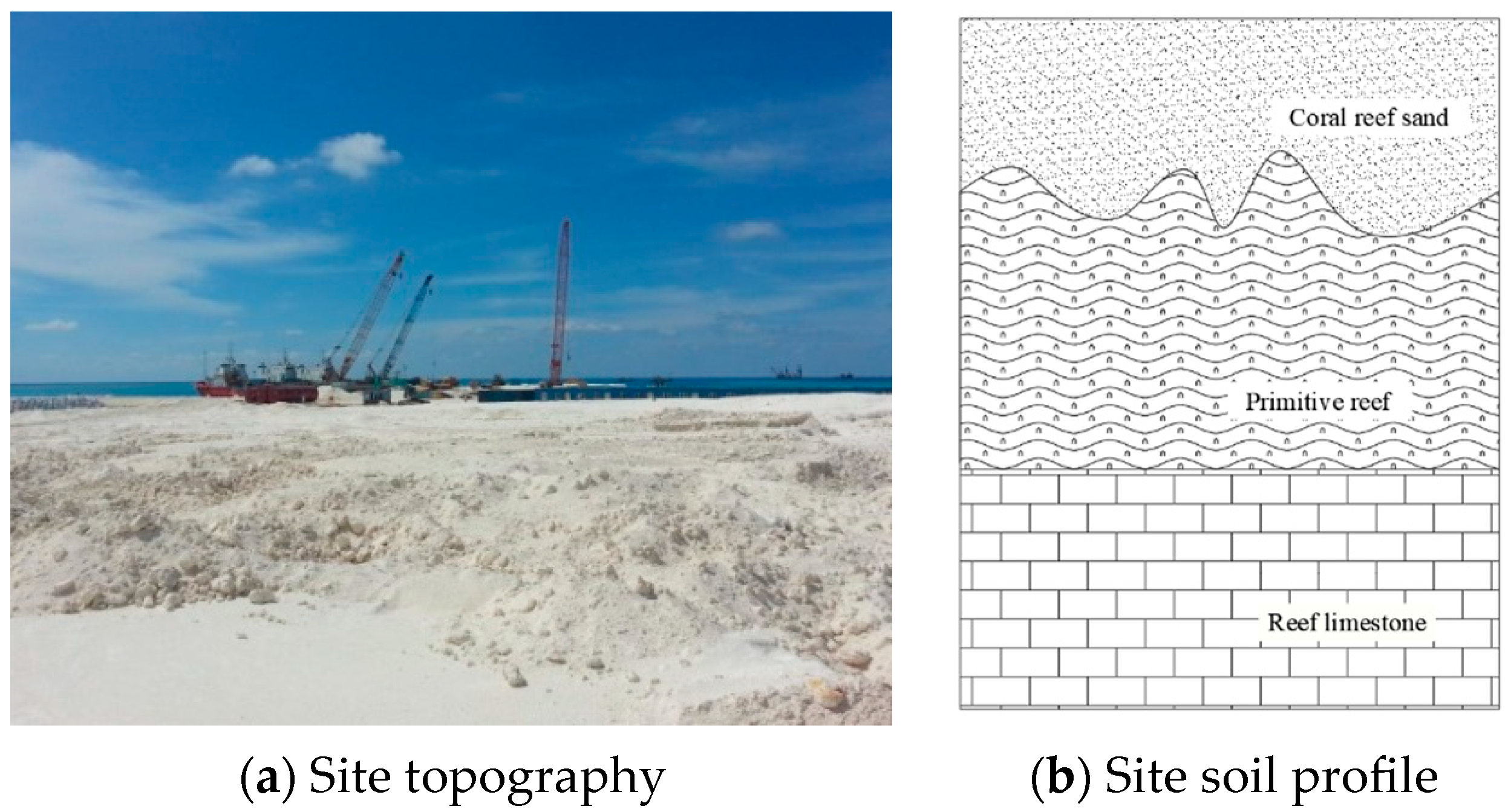



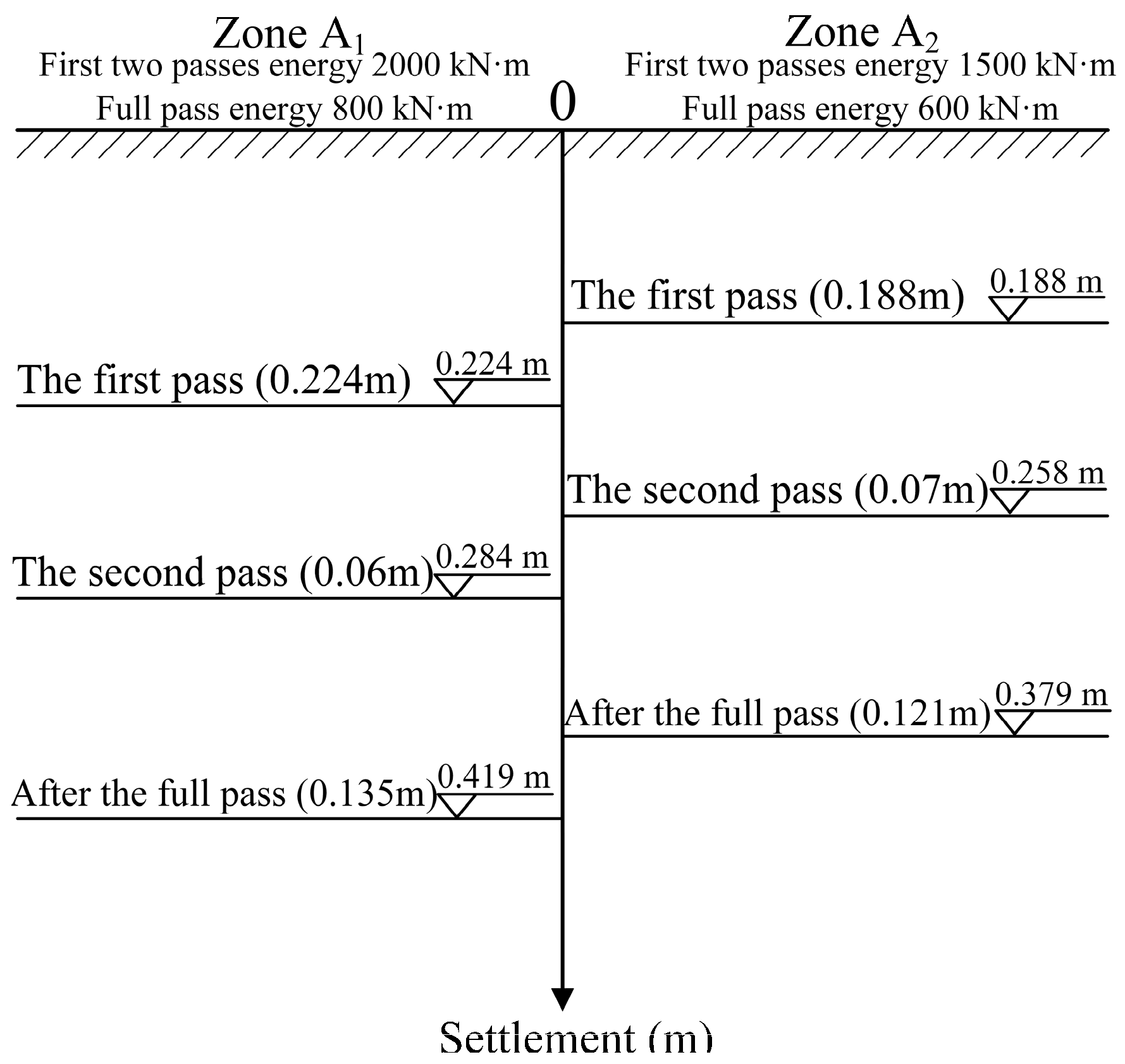
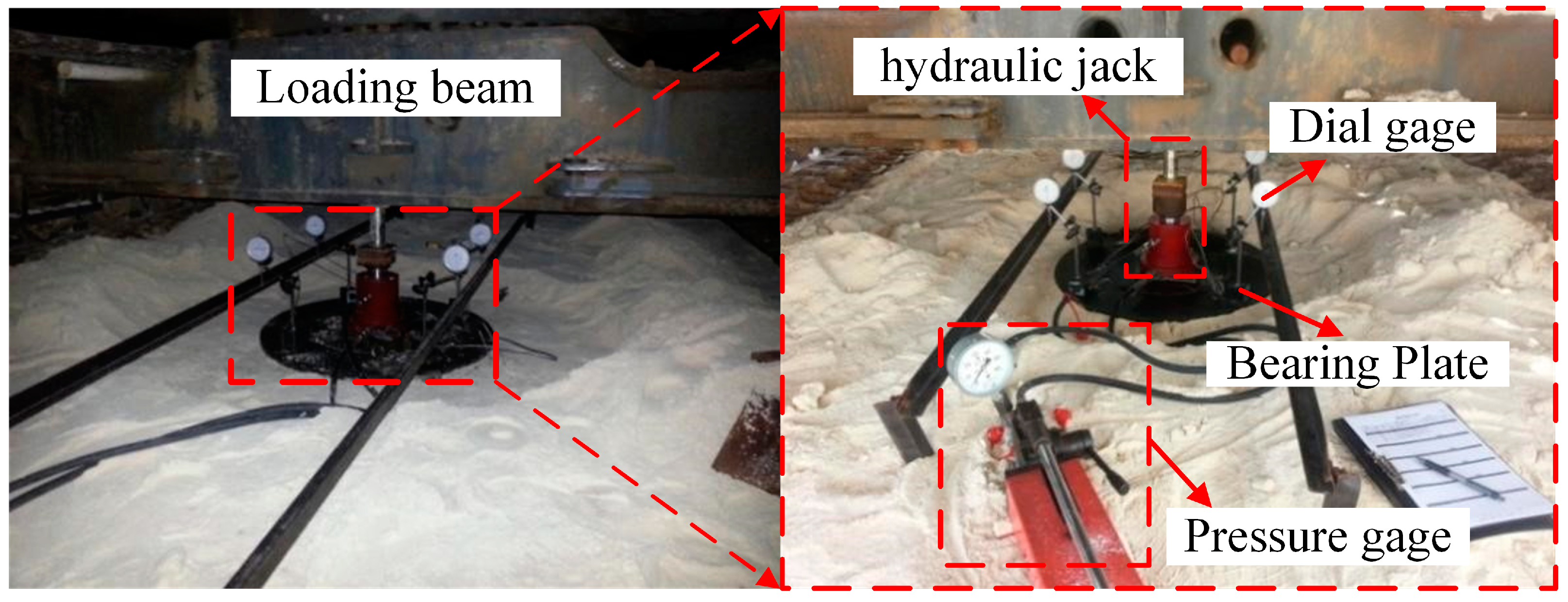
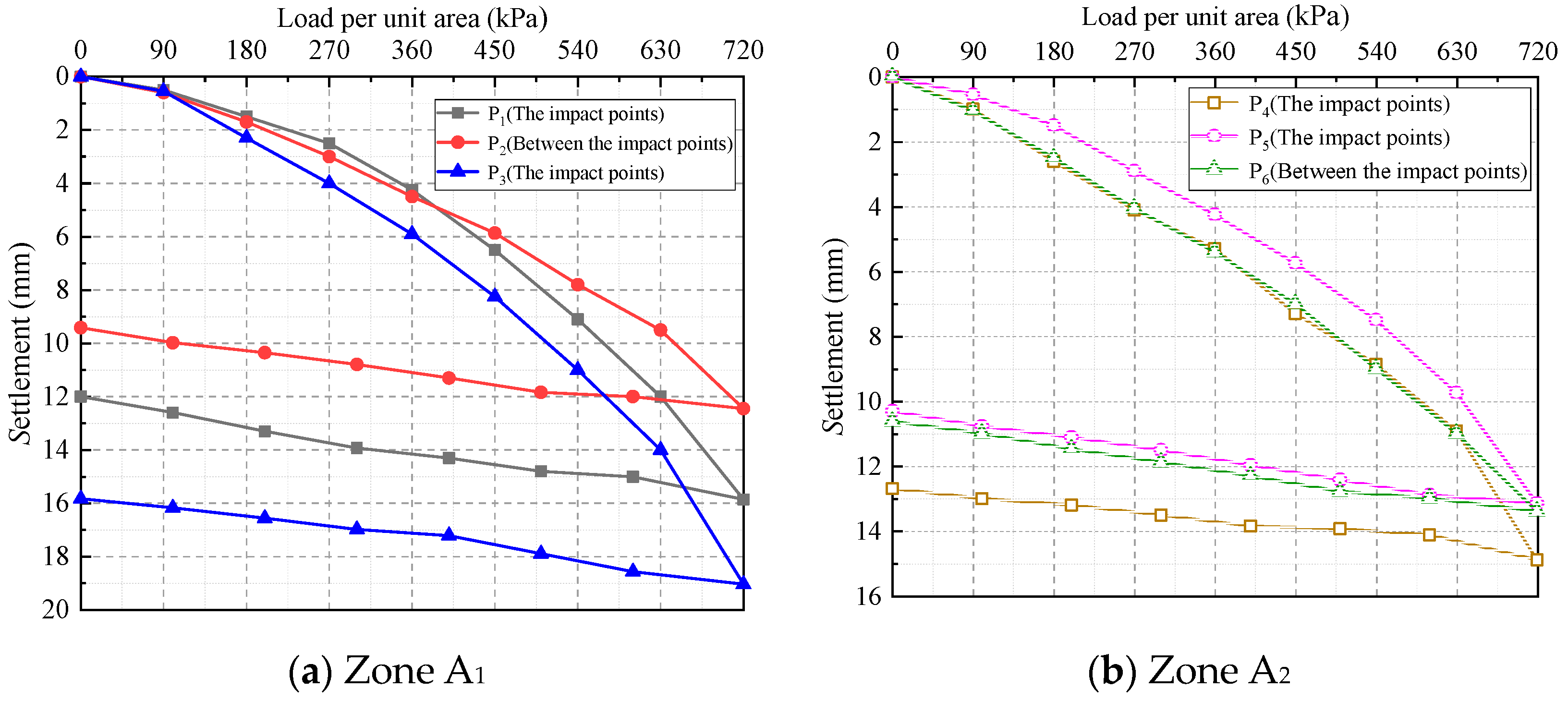
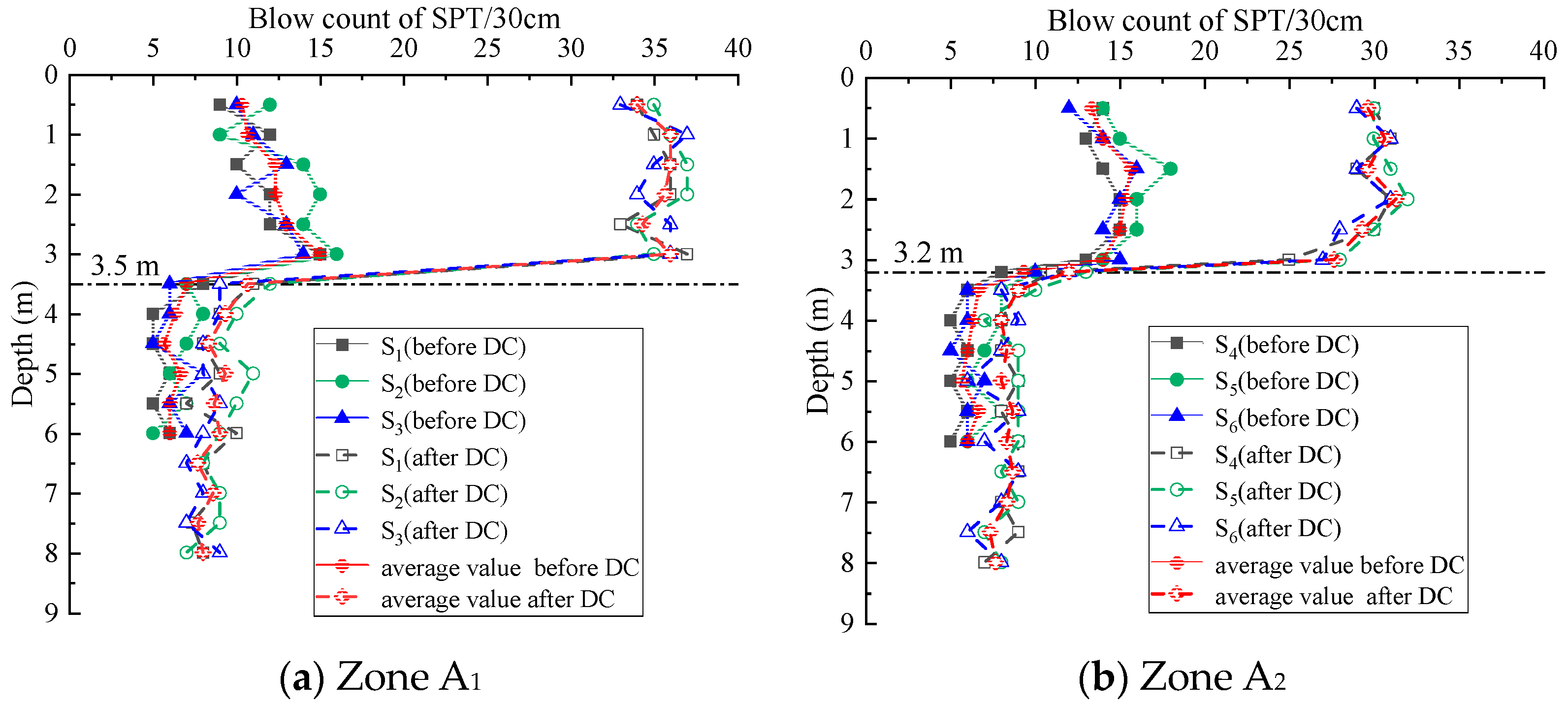
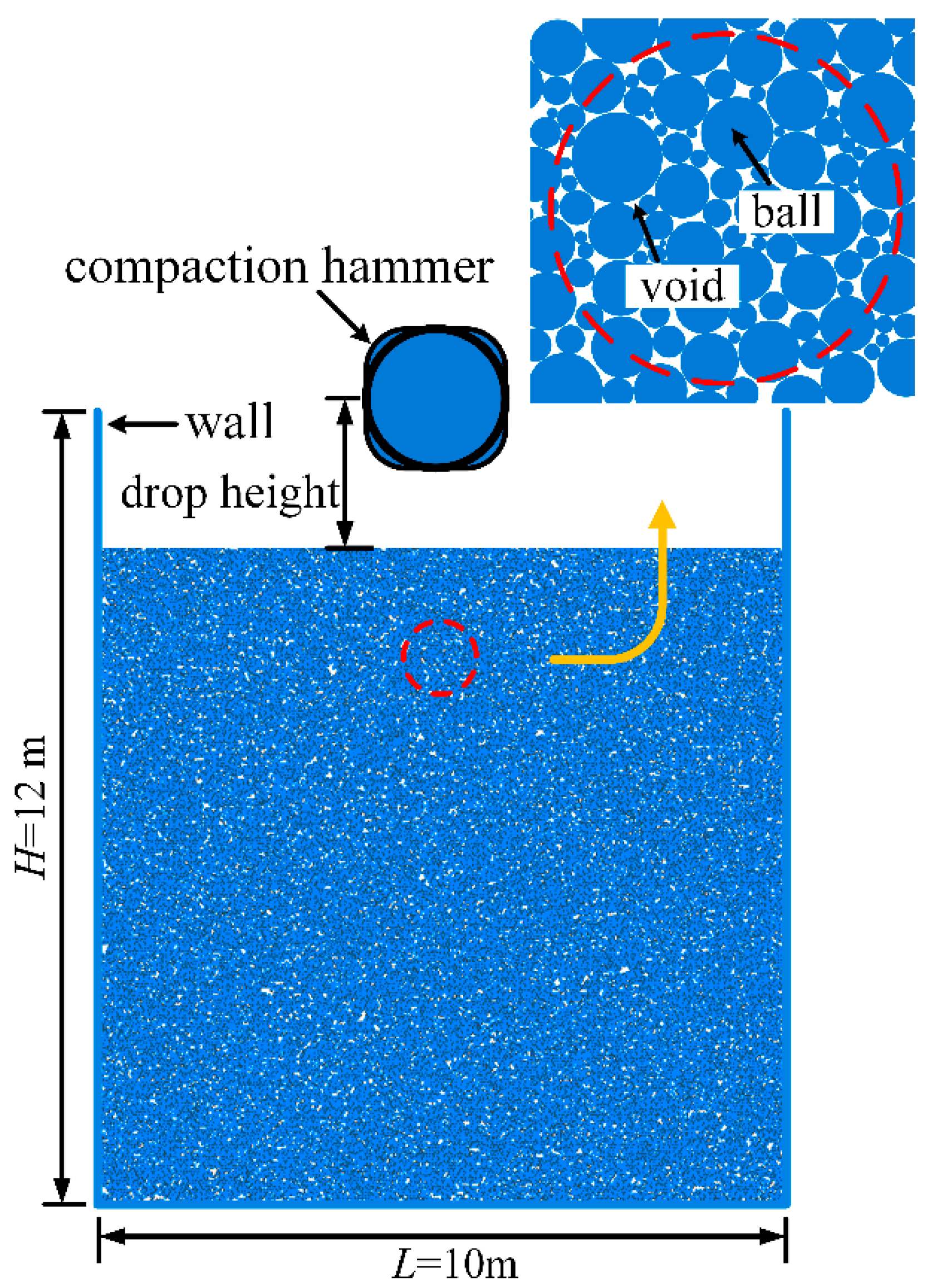
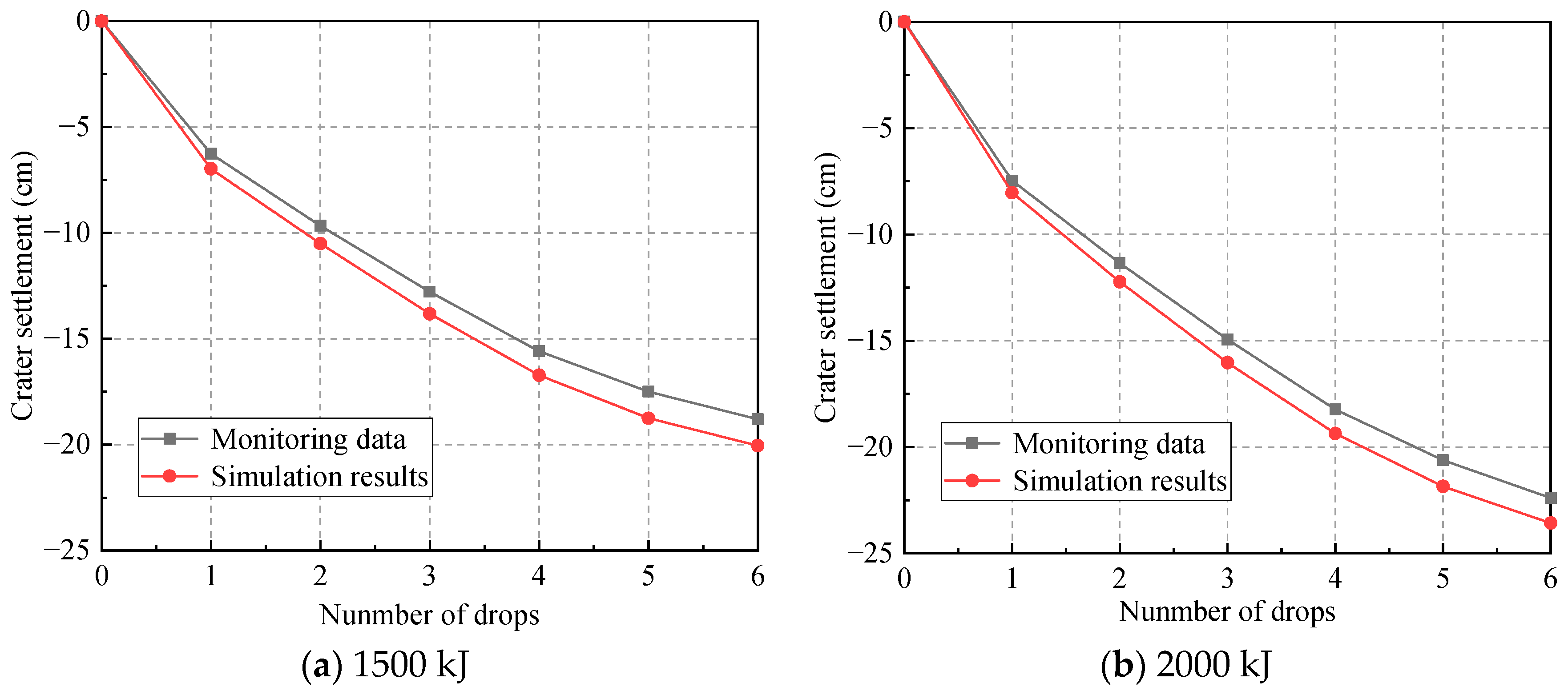
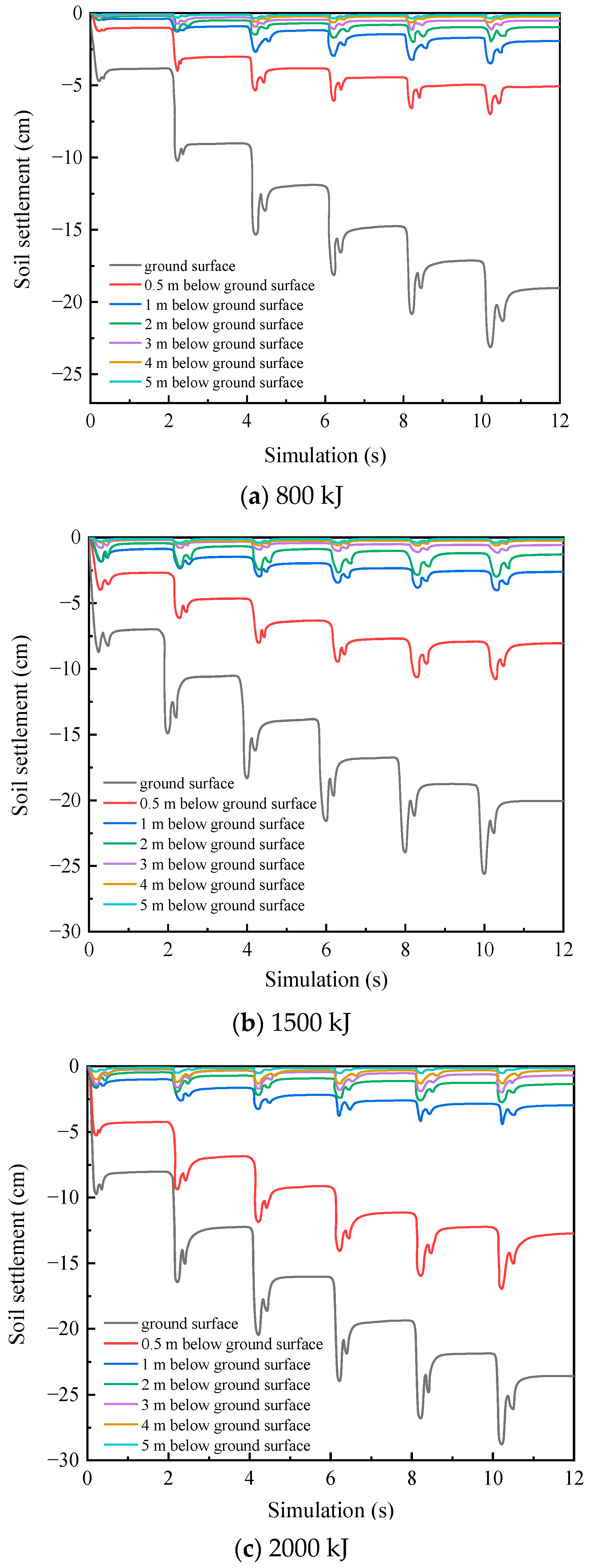
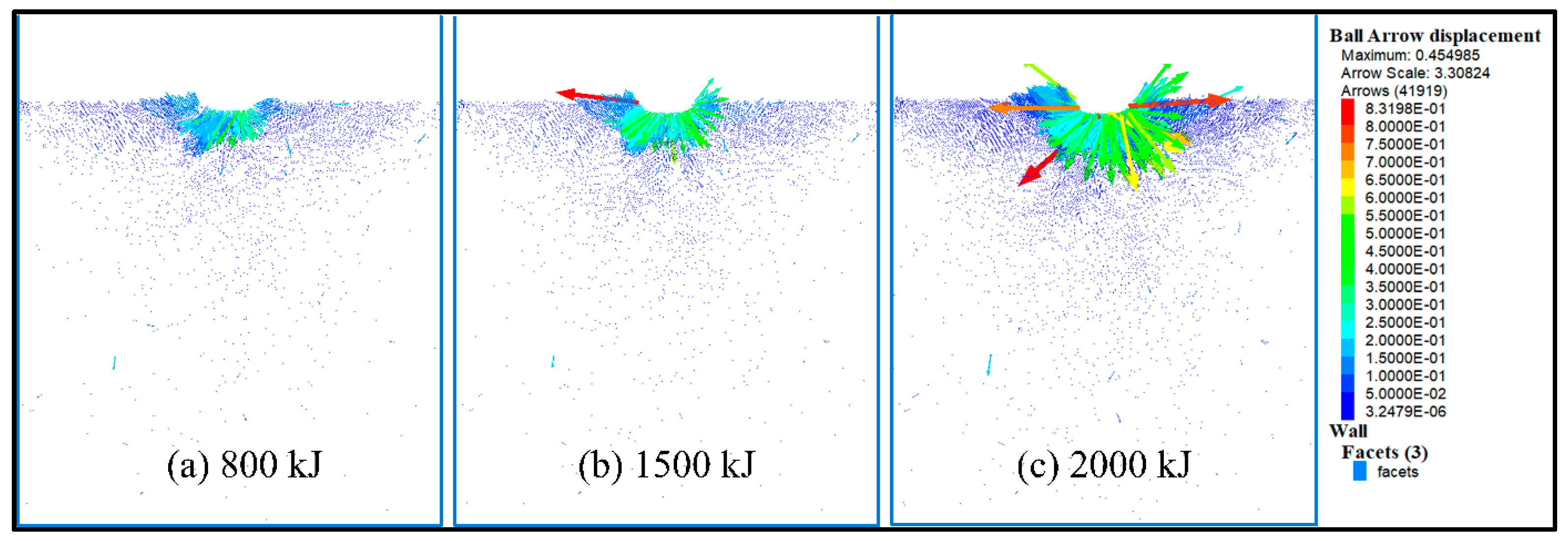

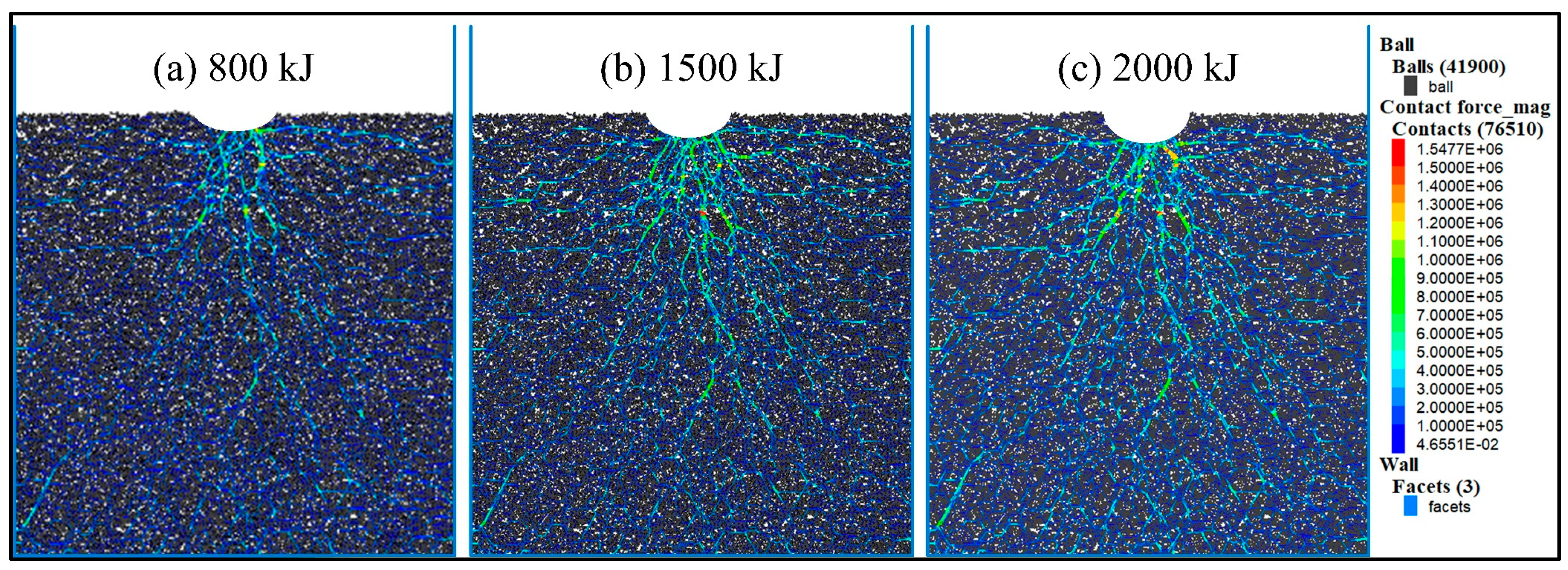
| Passes of Tamping | Impact Energy Level (kN·m) | Tamping Times | ||
|---|---|---|---|---|
| A1 | A2 | A1 | A2 | |
| First pass | 2000 | 1500 | 6 | 6 |
| Second pass | 2000 | 1500 | 6 | 6 |
| Third pass | 800 | 600 | 2 | 2 |
| Test Zone | Test Site | Ultimate Load Method | ||||
|---|---|---|---|---|---|---|
| Maximum Load (kPa) | Maximum Settlement (mm) | Maximum Resilience Value (mm) | Resilience Rate | Characteristic Value of Bearing Capacity (kPa) | ||
| A1 | P1 | 720 | 15.86 | 3.86 | 24.34% | >360 |
| P2 | 720 | 12.45 | 3.04 | 24.42% | >360 | |
| P3 | 720 | 19.03 | 3.2 | 16.82% | >360 | |
| A2 | P4 | 720 | 14.9 | 2.2 | 14.77% | >360 |
| P5 | 720 | 13.15 | 2.84 | 21.60% | >360 | |
| P6 | 720 | 13.39 | 2.76 | 20.61% | >360 | |
| Grain Size (mm) | ≥60 | 40~60 | 20~40 | 10~20 | 5~10 | 1~5 | 0.5~1.0 | 0~0.5 |
| Content (%) | 3.95 | 3.41 | 6.7 | 5.93 | 5.07 | 24.99 | 27.93 | 22.02 |
| Density/ρ (kg/m3) | 2730 |
| Maximum porosity ratio/emax | 1.84 |
| Minimum porosity ratio/emin | 0.88 |
| Elongation index/EI | 0.2–0.8 |
| Effective modulus/E* (kPa) | 7.5 × 106 |
| Stiffness ratio/k* | 15 |
| Frictional coefficient/μ | 0.65 |
| (kN·m−3) | 8 × 105 |
| (kN·m−3) | 2 × 105 |
| (kPa) | 5 × 103 |
| (kPa) | 1 × 103 |
| (°) | 32 |
Disclaimer/Publisher’s Note: The statements, opinions and data contained in all publications are solely those of the individual author(s) and contributor(s) and not of MDPI and/or the editor(s). MDPI and/or the editor(s) disclaim responsibility for any injury to people or property resulting from any ideas, methods, instructions or products referred to in the content. |
© 2024 by the authors. Licensee MDPI, Basel, Switzerland. This article is an open access article distributed under the terms and conditions of the Creative Commons Attribution (CC BY) license (https://creativecommons.org/licenses/by/4.0/).
Share and Cite
Gu, L.; Yang, W.; Wang, Z.; Wang, J.; Ye, G. Response of a Coral Reef Sand Foundation Densified through the Dynamic Compaction Method. J. Mar. Sci. Eng. 2024, 12, 1479. https://doi.org/10.3390/jmse12091479
Gu L, Yang W, Wang Z, Wang J, Ye G. Response of a Coral Reef Sand Foundation Densified through the Dynamic Compaction Method. Journal of Marine Science and Engineering. 2024; 12(9):1479. https://doi.org/10.3390/jmse12091479
Chicago/Turabian StyleGu, Linlin, Weihao Yang, Zhen Wang, Jianping Wang, and Guanlin Ye. 2024. "Response of a Coral Reef Sand Foundation Densified through the Dynamic Compaction Method" Journal of Marine Science and Engineering 12, no. 9: 1479. https://doi.org/10.3390/jmse12091479






